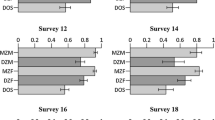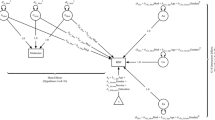The aims of this study were to examine the genetic contribution on physical activity (PA) within a nationwide population of young adult male twin pairs from Sweden and to investigate the equal environment assumption (EEA) in relation to PA. Information on PA was collected by questionnaires in 1998 and 2002 and the impact of genetic factors was estimated by structural equation modeling (SEM). The study included 1022 pairs of twins and the best fitting SEM-model gave a heritability of 49% (95% CI, 40–56%) for total PA and all PA dimensions showed genetic contributions between 40% and 65%. Non-shared environmental factors were also important, whereas shared environmental factors did not contribute to PA behaviors. The EEA was investigated with a linear regression model, examining if the twins contact frequency predicted within-pair differences in PA, and further by a simulation study. We found no support for violation of the EEA.
Similar content being viewed by others
References
Aarnio M., Winter T., Kujala U. M., and Kaprio J. (1997). Familial aggregation of leisure-time physical activity – a three generation study. Int. J. Sports Med. 18:549–556
Akaike H. (1987). Factor analysis and aic. Psychometrika 52:317–332
Anderssen N. and Wold B. (1992). Parental and peer influences on leisure-time physical activity in young adolescents. Res. Q. Exerc. Sport 63:341–348
Baecke J. A., Burema J. and Frijters J. E. (1982). A short questionnaire for the measurement of habitual physical activity in epidemiological studies. Am. J. Clin. Nutr. 36:936–942
Bauman K. E. and Ennett S. T. (1996). On the importance of peer influence for adolescent drug use: commonly neglected considerations. Addiction 91:185–198
Bergeman C. S., Neiderhiser J. M., Pedersen N. L., Plomin R. (2001). Genetic and environmental influences on social support in later life: a longitudinal analysis. Int. J. Aging Hum. Dev. 53:107–135
Beunen G. and Thomis M. (1999). Genetic determinants of sports participation and daily physical activity. Int. J. Obes. Relat Metab. Disord. 23(Suppl 3):S55–S63
Boomsma D. I., van den Bree M. B., Orlebeke J. F. and Molenaar P. C. (1989). Resemblances of parents and twins in sports participation and heart rate. Behav. Genet. 19:123–141
Cederlöf R., Friberg L., Jonsson E. and Kaij L. (1961). Studies of similarity diagnosis in twins with the aid of mailed questionnaires. Acta Genet. Med. Gemellol. (Roma). 11:338–362
Cronk N. J., Slutske W. S., Madden P. A., Bucholz K. K., Reich W. and Heath A. C. (2002). Emotional and behavioral problems among female twins: an evaluation of the equal environments assumption. J. Am. Acad. Child Adolesc. Psychiatry 41:829–837
Eaves L., Foley D. and Silberg J. (2003). Has the “Equal Environments” assumption been tested in twin studies?. Twin Res. 6:486–489
Evans D. M., Gillespie N. A., Martin N. G. (2002). Biometrical genetics. Biol. Psychol. 61:33–51
Evans D. M. and Martin N. G. (2000). The validity of twin studies. GeneScreen 1:77–79
Heath E. M., Morken N. W., Campbell K. A., Tkach D., Boyd E. A. and Strom D. A. (2001). Use of buccal cells collected in mouthwash as a source of DNA for clinical testing. Arch. Pathol. Lab Med. 125:127–133
Heller R. F., O’Connell D. L., Roberts D. C., Allen J. R., Knapp J. C., Steele P. L. and Silove D. (1988). Lifestyle factors in monozygotic and dizygotic twins. Genet. Epidemiol. 5:311–321
Horwitz A. V., Videon T. M., Schmitz M. F. and Davis D. (2003). Rethinking twins and environments: possible social sources for assumed genetic influences in twin research. J. Health Soc. Behav. 44:111–129
Kamei Y., Miura S., Suzuki M., Kai Y., Mizukami J., Taniguchi T., Mochida K., Hata T., Matsuda J., Aburatani H., Nishino I., and Ezaki O. (2004). Skeletal muscle FOXO1 (FKHR) transgenic mice have less skeletal muscle mass, down-regulated Type I (slow twitch/red muscle) fiber genes, and impaired glycemic control. J. Biol. Chem. 279:41114–41123
Kaprio J., Koskenvuo M. and Sarna S. (1981). Cigarette smoking, use of alcohol, and leisure-time physical activity among same-sexed adult male twins. Prog. Clin. Biol. Res. 69(Pt C):37–46
Kendler K. S. and Gardner C. O. (1998). Twin studies of adult psychiatric and substance dependence disorders: are they biased by differences in the environmental experiences of monozygotic and dizygotic twins in childhood and adolescence?. Psychol. Med. 28:625–633
Kendler K. S. and Prescott C. A. (1998). Cannabis use, abuse, and dependence in a population-based sample of female twins. Am. J. Psychiatry 155:1016–1022
Klump K. L., Holly A., Iacono W. G., McGue M., and Willson L. E. (2000). Physical similarity and twin resemblance for eating attitudes and behaviors: a test of the equal environments assumption. Behav. Genet. 30:51–58
Lauderdale D. S., Fabsitz R., Meyer J. M., Sholinsky P., Ramakrishnan V. and Goldberg J. (1997). Familial determinants of moderate and intense physical activity: a twin study. Med. Sci. Sports Exerc. 29:1062–1068
Livingstone M. B. and Black A. E. (2003). Markers of the validity of reported energy intake. J. Nutr. 133(Suppl 3):895S–920S
Loos R. J., Rankinen T., Tremblay A., Perusse L., Chagnon Y., and Bouchard C. (2005). Melanocortin-4 receptor gene and physical activity in the Quebec Family Study. Int. J. Obes. Relat. Metab. Disord. 29:420–428
Madden P. A., Bucholz K. K., Todorov A. A., Grant J. D., and Heath A. C. (2002). The assessment of peer selection and peer environmental influences on behavior using pairs of siblings or twins. Twin. Res. 5:38–43
Maia J. A., Thomis M. and Beunen G. (2002). Genetic factors in physical activity levels: a twin study. Am. J. Prev. Med. 23:87–91
Neale M. C., Boker S. M., Xie G., and Maes H. H. (2002). Mx: Statistical Modeling. VCU Department of Psychiatry, Richmond, VA
Neale M. C., Cardon L. R. (1992). Methodology for Genetic Studies of Twins and Families. Kluwer Academic Publishers, Dordrecht
Pedersen, N., and Lichtenstein P. (2000). Scientific Evaluation of the Swedish Twin Registry. Swedish Council for Planning and Coordination of Research. Report no 2000-10, Stockholm, Sweden
Perusse L., Leblanc C., Bouchard C. (1988). Familial resemblance in lifestyle components: results from the Canada Fitness Survey. Can. J. Public Health 79:201–205
Perusse L., Tremblay A., Leblanc C. and Bouchard C. (1989). Genetic and environmental influences on level of habitual physical activity and exercise participation. Am. J. Epidemiol. 129:1012–1022
Philippaerts R. M., Westerterp K. R. and Lefevre J. (1999). Doubly labelled water validation of three physical activity questionnaires. Int. J. Sports Med. 20:284–289
Pols M. A., Peeters P. H., Bueno-De-Mesquita H. B., Ocke M. C., Wentink C. A., Kemper H. C. and Collette H. J. (1995). Validity and repeatability of a modified Baecke questionnaire on physical activity. Int. J. Epidemiol. 24:381–388
Rasmussen F. and Johansson-Kark M. (2002). The Swedish Young Male Twins Register: a resource for studying risk factors for cardiovascular disease and insulin resistance. Twin. Res. 5:433–435
SAS Institute (1999). The Statistical Analysis System, Version 8. SAS Institute Inc. Cary, NC
Sham P. (1998). Statistics in Human Genetics. Hodder Headline Group, London
Simonen R., Levalahti E., Kaprio J., Videman T. and Battie M. C. (2004). Multivariate genetic analysis of lifetime exercise and environmental factors. Med. Sci. Sports Exerc. 36:1559–1566
Simonen R. L., Perusse L., Rankinen T., Rice T., Rao D. C., and Bouchard C. (2002). Familial aggregation of physical activity levels in the Quebec Family Study. Med. Sci. Sports Exerc. 34:1137–1142
Simonen R. L., Rankinen T., Perusse L., Leon A. S., Skinner J. S., Wilmore J. H., Rao D. C. and Bouchard C. (2003a). A dopamine D2 receptor gene polymorphism and physical activity in two family studies. Physiol. Behav. 78:751–757
Simonen R. L., Rankinen T., Perusse L., Rice T., Rao D. C., Chagnon Y. and Bouchard C. (2003b). Genome-wide linkage scan for physical activity levels in the Quebec Family study. Med. Sci. Sports Exerc. 35:1355–1359
Stefan N., Vozarova B., Del Parigi A., Ossowski V., Thompson D. B., Hanson R. L., Ravussin E. and Tataranni P. A. (2002). The Gln223Arg polymorphism of the leptin receptor in Pima Indians: influence on energy expenditure, physical activity and lipid metabolism. Int. J. Obes. Relat. Metab. Disord. 26:1629–1632
Suwa M., Nakano H., Higaki Y., Nakamura T., Katsuta S. and Kumagai S. (2003). Increased wheel-running activity in the genetically skeletal muscle fast-twitch fiber-dominant rats. J. Appl. Physiol. 94:185–192
Swallow J. G., Carter P. A., Garland T. Jr. (1998). Artificial selection for increased wheel-running behavior in house mice. Behav. Genet. 28:227–237
Wold B. and Anderssen N. (1992). Health promotion aspects of family and peer influences on sports participation. Int. J. Sport Psychol. 23:343–359
World Health Organization (2002). The World Health Report 2002: Reducing risks to health, promoting healthy life. World Health Organization, Geneva
Acknowledgments
This study was supported by grants from the Swedish Council for Working Life and Social Research (contract number 2202-0623) to Finn Rasmussen.
Author information
Authors and Affiliations
Corresponding author
Rights and permissions
About this article
Cite this article
Eriksson, M., Rasmussen, F. & Tynelius, P. Genetic Factors in Physical Activity and the Equal Environment Assumption – the Swedish Young Male Twins Study. Behav Genet 36, 238–247 (2006). https://doi.org/10.1007/s10519-005-9018-7
Received:
Accepted:
Published:
Issue Date:
DOI: https://doi.org/10.1007/s10519-005-9018-7




